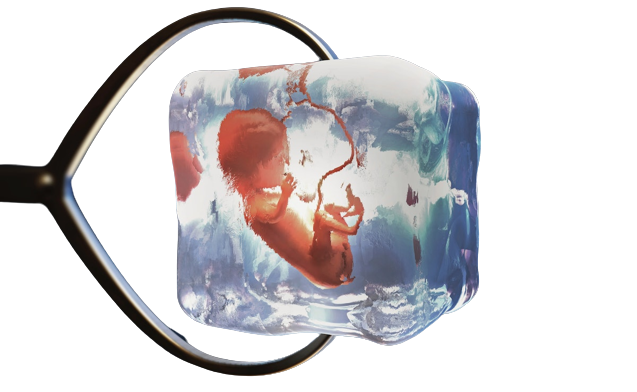Frozen Embryo Transfer (FET)
What Are Frozen Embryos?
During ovarian stimulation, the ovaries may produce a large number of eggs. These eggs are fertilized with sperm in the laboratory, resulting in embryos that develop over several days.
While some embryos are transferred to the uterus, transferring too many can lead to complications, including multiple pregnancies. Therefore, excess embryos are often frozen for future use. These embryos can remain frozen for months or even years, preserving their viability for subsequent transfer.

What Are Frozen Embryos?
During ovarian stimulation, the ovaries may produce a large number of eggs. These eggs are fertilized with sperm in the laboratory, resulting in embryos that develop over several days.
While some embryos are transferred to the uterus, transferring too many can lead to complications, including multiple pregnancies. Therefore, excess embryos are often frozen for future use. These embryos can remain frozen for months or even years, preserving their viability for subsequent transfer.

Steps of Frozen Embryo Transfer
FET involves a series of well-coordinated stages that span from pre-transfer preparation to post-transfer monitoring.

Step 1
Monitoring Follicular Development and Ovulation Timing
FET must be performed at a precise time after ovulation, typically a few days later when the uterine lining is adequately prepared, and hormonal levels are optimal for embryo implantation.
Ultrasound imaging and blood tests are used to monitor ovulation and assess the uterine lining’s readiness. If the lining or ovarian conditions are not favorable, the procedure may be delayed, and hormonal therapy might be prescribed to enhance preparation.
The timing of the embryo transfer also depends on the developmental stage of the frozen embryos. Embryos frozen at more advanced stages are transferred later in the cycle compared to those frozen at earlier stages.
Step 2
Embryo Transfer
On the day of transfer, the embryos are thawed in the morning. Typically, one or two embryos are transferred during each cycle to minimize the risks associated with multiple pregnancies.
The procedure is similar to a fresh IVF transfer. A vaginal speculum is used to gently open the vaginal walls, providing a clear view of the cervix. A soft catheter is then passed through the cervix into the uterus, and the embryos are deposited along with a small amount of fluid.
The process is quick, simple, and painless, usually not requiring anesthesia. The patient is advised to rest for about 30 minutes afterward before going home.
Step 3
Hormonal and Medical Support
Post-transfer, hormonal support is crucial to ensure successful implantation and maintenance of pregnancy. Progesterone is commonly prescribed, especially for women with ovulatory dysfunction or other hormonal imbalances.
Additionally, anticoagulants, aspirin, or nutritional supplements may be recommended. During this period, which lasts from the transfer until the pregnancy test, the woman is advised to avoid strenuous activities and prioritize rest.
Step 4
Pregnancy Testing
A pregnancy test is conducted 12–14 days after the embryo transfer. A blood test measuring human chorionic gonadotropin (hCG) levels is preferred over a home pregnancy test due to its higher accuracy and sensitivity.
The hCG levels are monitored for a steady increase, with values doubling approximately every 48 hours, indicating a healthy progression of pregnancy
Step 5
Follow-Up and Monitoring
If the pregnancy test is positive, a transvaginal ultrasound is scheduled about three weeks later. This examination confirms the number of embryos that successfully implanted and checks for fetal heart activity. Reaching this stage significantly reduces the likelihood of pregnancy loss.
Frequently Asked Questions FAQ
What Is Frozen Embryo Transfer (FET)?
FET is a process in which frozen embryos are thawed and transferred into the uterus after proper preparation of the uterine lining. Unlike a fresh IVF cycle, FET does not require ovarian stimulation or egg retrieval, as the embryos are already available. This process can be performed when the woman is physically and emotionally ready.
Each FET cycle involves several steps, similar to any other therapeutic procedure. It can be conducted during the natural menstrual cycle, provided ovulation and the uterine lining are monitored closely to determine the optimal timing for transfer. Doctors also recommend evaluating the uterine cavity to rule out any abnormalities that might hinder implantation. This evaluation may involve ultrasound imaging, hysterosalpingography, or hysteroscopy.
Success Rates of Frozen Embryo Transfer
FET success rates are comparable to fresh IVF cycles. Importantly, FET does not increase the risk of congenital anomalies or pregnancy-related complications.
Success rates depend on several factors, including:
The number and quality of embryos.
The woman’s age.
The underlying cause of infertility.
Additionally, the expertise of the medical center and the treating physician plays a pivotal role. FET requires advanced equipment, a skilled medical team, and meticulous execution to achieve optimal outcomes.
Frozen Embryo Transfer is a promising option for individuals undergoing assisted reproductive treatments, offering flexibility and improved pregnancy outcomes while minimizing risks.
